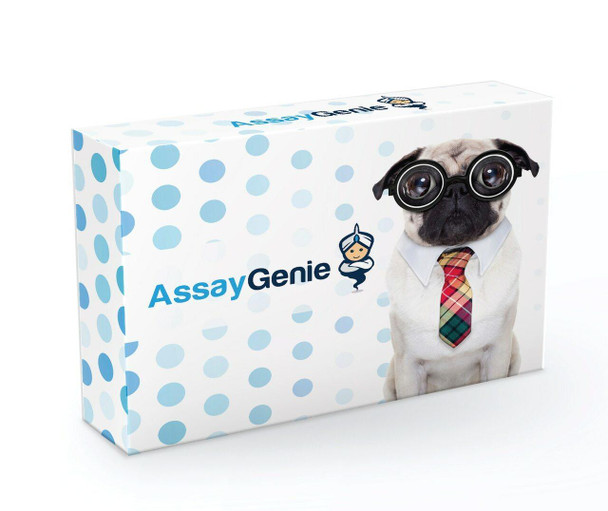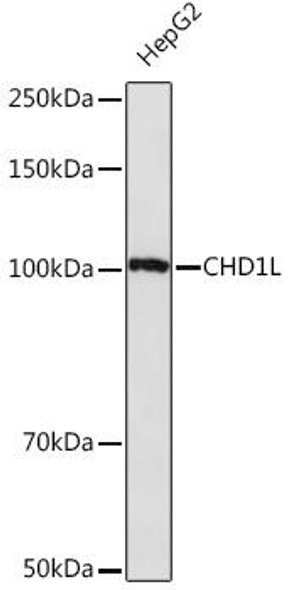Anti-ATRX Antibody (CAB17378)
- SKU:
- CAB17378
- Product type:
- Antibody
- Reactivity:
- Human
- Host Species:
- Rabbit
- Isotype:
- IgG
- Antibody Type:
- Polyclonal Antibody
- Research Area:
- Epigenetics and Nuclear Signaling
Description
| Antibody Name: | Anti-ATRX Antibody |
| Antibody SKU: | CAB17378 |
| Antibody Size: | 20uL, 50uL, 100uL |
| Application: | WB |
| Reactivity: | Human |
| Host Species: | Rabbit |
| Immunogen: | Recombinant protein of human ATRX. |
| Application: | WB |
| Recommended Dilution: | WB 1:500 - 1:2000 |
| Reactivity: | Human |
| Positive Samples: |
| Immunogen: | Recombinant protein of human ATRX. |
| Purification Method: | Affinity purification |
| Storage Buffer: | Store at -20°C. Avoid freeze / thaw cycles. Buffer: PBS with 0.02% sodium azide, 50% glycerol, pH7.3. |
| Isotype: | IgG |
| Sequence: | Email for sequence |
| Gene ID: | 546 |
| Uniprot: | P46100 |
| Cellular Location: | |
| Calculated MW: | 282kDa |
| Observed MW: | Refer to figures |
| Synonyms: | JMS, XH2, XNP, MRX52, RAD54, RAD54L, ZNF-HX, ATRX |
| Background: | The protein encoded by this gene contains an ATPase/helicase domain, and thus it belongs to the SWI/SNF family of chromatin remodeling proteins. This protein is found to undergo cell cycle-dependent phosphorylation, which regulates its nuclear matrix and chromatin association, and suggests its involvement in the gene regulation at interphase and chromosomal segregation in mitosis. Mutations in this gene are associated with X-linked syndromes exhibiting cognitive disabilities as well as alpha-thalassemia (ATRX) syndrome. These mutations have been shown to cause diverse changes in the pattern of DNA methylation, which may provide a link between chromatin remodeling, DNA methylation, and gene expression in developmental processes. Multiple alternatively spliced transcript variants encoding distinct isoforms have been reported. |
| UniProt Protein Function: | ATRX: a global transcriptional regulator. Belongs to the SNF2 family of proteins, many of which modify gene expression via chromatin remodeling activity. Involved in the developmental silencing of imprinted genes in the brain. Contains one PxVxL motif, which is required for interaction with chromoshadow domains. This motif requires additional residues at -7, -6, +4 and +5 relative to the central V which contact the chromoshadow domain. Constitutive mutations in ATRX are associated with brain, facial, and genital abnormalities, and alpha thalassemia. Acquired mutations in ATRX have been observed in preleukemic conditions. Six alternatively spliced human isoforms have been described. |
| UniProt Protein Details: | Protein type:DNA repair, damage; EC 3.6.4.12; Helicase; Ubiquitin conjugating system Chromosomal Location of Human Ortholog: Xq21.1 Cellular Component: centric heterochromatin; condensed nuclear chromosome, centromeric region; nuclear body; nuclear chromosome, telomeric region; nuclear heterochromatin; nuclear subtelomeric heterochromatin; nucleoplasm; nucleus; PML body Molecular Function:ATP binding; chromatin binding; chromo shadow domain binding; DNA binding; DNA helicase activity; DNA translocase activity; helicase activity; histone binding; metal ion binding; methylated histone residue binding; protein binding Biological Process: chromatin remodeling; covalent chromatin modification; DNA damage response, signal transduction by p53 class mediator; DNA duplex unwinding; DNA methylation; DNA recombination; DNA repair; DNA replication-independent nucleosome assembly; forebrain development; meiotic spindle organization; multicellular organism growth; negative regulation of maintenance of mitotic sister chromatid cohesion, telomeric; negative regulation of telomeric RNA transcription from RNA pol II promoter; nucleosome assembly; positive regulation of nuclear cell cycle DNA replication; positive regulation of telomere maintenance; positive regulation of telomeric RNA transcription from RNA pol II promoter; positive regulation of transcription from RNA polymerase II promoter; post-embryonic forelimb morphogenesis; regulation of histone H3-K9 trimethylation; regulation of transcription, DNA-templated; replication fork processing; seminiferous tubule development; Sertoli cell development; spermatogenesis; transcription, DNA-dependent Disease: Alpha-thalassemia Myelodysplasia Syndrome; Alpha-thalassemia/mental Retardation Syndrome, X-linked; Mental Retardation-hypotonic Facies Syndrome, X-linked, 1 |
| NCBI Summary: | The protein encoded by this gene contains an ATPase/helicase domain, and thus it belongs to the SWI/SNF family of chromatin remodeling proteins. This protein is found to undergo cell cycle-dependent phosphorylation, which regulates its nuclear matrix and chromatin association, and suggests its involvement in the gene regulation at interphase and chromosomal segregation in mitosis. Mutations in this gene are associated with X-linked syndromes exhibiting cognitive disabilities as well as alpha-thalassemia (ATRX) syndrome. These mutations have been shown to cause diverse changes in the pattern of DNA methylation, which may provide a link between chromatin remodeling, DNA methylation, and gene expression in developmental processes. Multiple alternatively spliced transcript variants encoding distinct isoforms have been reported. [provided by RefSeq, Jul 2017] |
| UniProt Code: | P46100 |
| NCBI GenInfo Identifier: | 530788276 |
| NCBI Gene ID: | 546 |
| NCBI Accession: | NP_000480.3 |
| UniProt Secondary Accession: | P46100,P51068, Q15886, Q59FB5, Q59H31, Q5H9A2, Q5JWI4 Q7Z2J1, Q9H0Z1, Q9NTS3, D3DTE2, |
| UniProt Related Accession: | P46100 |
| Molecular Weight: | 151,556 Da |
| NCBI Full Name: | transcriptional regulator ATRX isoform 1 |
| NCBI Synonym Full Names: | ATRX, chromatin remodeler |
| NCBI Official Symbol: | ATRX |
| NCBI Official Synonym Symbols: | JMS; XH2; XNP; MRX52; RAD54; RAD54L; ZNF-HX |
| NCBI Protein Information: | transcriptional regulator ATRX |
| UniProt Protein Name: | Transcriptional regulator ATRX |
| UniProt Synonym Protein Names: | ATP-dependent helicase ATRX; X-linked helicase II; X-linked nuclear protein; XNP; Znf-HX |
| Protein Family: | Transcriptional regulator |
| UniProt Gene Name: | ATRX |







